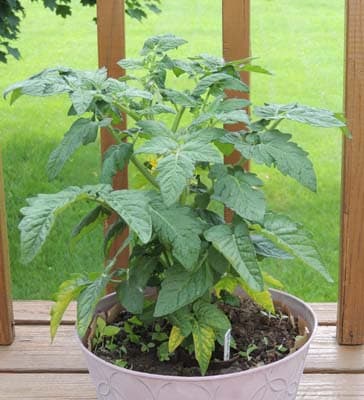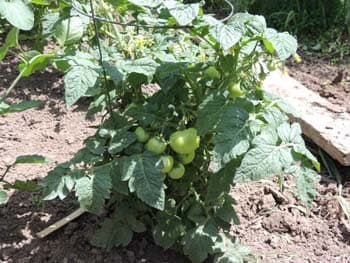How to Grow Tiny Tim Tomato Plants

Tiny Tim tomato is an extremely early miniature cherry tomato plant. It is a dwarf, determinate plant, growing just 12 to 18 inches. Because of the plants’ compact size, Tiny Tim tomato plants are perfect for container gardening on your balcony or deck. And, they are also candidates for planting in small urban gardens, too.
The plant produces a profusion of small, 3/4 to 1-inch diameter fruits. They are among the largest of the cherry-sized varieties. One of the benefits of growing this small-fruited variety is you will be eating tomatoes long before your main crop begins to ripen.
How to Start Tiny Tim Tomato Seeds
Tomato plants are usually started indoors. Planting Tiny Tim tomato seeds is an exciting time. It is one of the very first gardening projects of the year. Without a doubt, after a long winter, you are itching to get your hands back into some “dirt”.
Begin growing tiny Tim tomato seeds indoors in small containers, eight to ten weeks before the last frost date for your area. First, select sterile containers. Then, sow Tiny Tim tomato seeds about 1/8″ inch deep, using sterile seed starting soil. Seeds sprout in 10-14 days, depending upon soil temperature. We highly recommend a germination mat for starting plants indoors. Without a doubt, germination mats help to sprout seeds faster and with a higher germination rate.
As soon as the seedlings emerge, they need full sunlight to grow sturdy. Lack of sunlight causes the plants to grow “leggy”. Because of this, we highly recommend using grow lights to supplement the amount of available sunlight.
Tip: To help your plants grow sturdy, place a small fan on low nearby. Or, lightly brush the tops of the plants with your hands a couple of times each day.

How to Grow Tiny Tim Tomato Plants
Learn all about growing these unique tomatoes:
- How to Grow Tomatoes – From planting seeds to harvesting fruit, we’ve gotcha covered.
- Staking Tomato Plants – Large plants and huge tomatoes require a sturdy tomato cage or staking to help avoid plant disease and keep fruit off the ground.
- Pruning Tomatoes – In fact, pruning helps avoid plant disease.
- Plant Problems and Disease – Above all, remember the old saying “an ounce of prevention is worth a pound of cure.”
Additionally, this variety tends to die out before the end of the season. So, you will want to grow another variety to keep you supplied with fresh tomatoes all the way to the first fall frost.
How to Grow Tiny Tim Tomatoes in Containers
The determinate habit of his variety of plants makes them a eat candidate for a container garden.
Use a 12″ diameter or larger container. Only use a container with a hole in the bottom for drainage. Grow one plant in the center of the container.
Because of the limited amount of moisture and nutrients in the soil, it is important to monitor the moisture level. In hot, dry weather, you may need to add water every day or so. Also, add fertilizer every two to three weeks. The plants respond well to liquid fertilizer.
While these plants don’t usually require staking or caging, they sometimes receive less than full sunlight on a patio or balcony. As a result, the plants may grow lankier than normal. so, staking will help to support the plant.
Tomato Cages and Staking Plants
Because of their small, determinate nature, Tiny Tim plants do not require staking. Some people, including this author, put them in smaller tomato cages, to assure the plants do not droop toward the end of the season. More on staking tomatoes.
Insects and Pests
Tomato plants can experience insect problems with tomato hornworms, cutworms, and a few other garden pests. Also, if not staked or caged, snails and slugs will munch on the ripening fruit.
Birds will occasionally peck holes in red fruit.
Did you Know? Tomato plants emit a mild toxin that discourages many small insects from bothering them. This toxin can also cause skin itching and irritation.
More on Tomato Plant Problems – Remember the old saying “anonce of prevention is worth a pound of cure”.
Tip: Borage plants can be used as companion plants, to deter Tomato hornworms
Did you Know? Tomato plants (not the fruit) are used to make an organic insect repellent. See Tomato “Juice” Spray
Plant Disease
Several plant problems can arise, usually in the mid-summer heat and humidity. Blights and fungus infections can occur in high humidity. Early treatment with fungicides is effective. Spacing plants too close cuts down air circulation and promotes disease.
Blossom end rot can also affect the fruit. This is a round, brown, indented spot on the bottom of the tomato. It is caused by either uneven watering or a lack of calcium in the soil. More on Blossom End Rot.
Tip: Do not water at night if possible in hot and humid weather if possible. Moisture and humidity combined with high temperatures promote plant diseases. If possible, water at the roots.
Plant Hardiness
Tomatoes like it hot! They will die if exposed to frost. Make sure to plant them after the last frost.
Tip#1: Cover your young seedling if frost is predicted. A simple and easy cover for small seedlings is to buy large or extra large plastic disposable cups. Place them over the seedling at dusk, and remove them in the morning. It is usually little or no wind on nights with frost, so they are not easily tipped over.
Tip#2: If you get a light frost overnight and you did not cover up your plants. Go out early before the sun rises, and spray your plants with the garden hose. This melts the ice off the plants and may save them.
Harvesting and Storing Tomatoes
Days to Maturity: Just 55 days from setting transplants in the garden.
Tomatoes store well in a cool, dry location. Do not put them in the refrigerator. While they last longer in the refrigerator, they will lose their flavor and texture. Keep them out of direct sunlight.
Just before frost, pick tomatoes while they are still green or orange. First, wash them thoroughly. Second, rinse in a light solution of 1 gallon of water and a tablespoon of bleach. This kills off bacteria that rot the fruit. Then, allow them to dry. Finally, put them in a cool, dry, dark place.
To ripen tomatoes indoors, bring a couple at a time to a warm, sunny window.
Tomato Canning Guidelines – Information on canning tomatoes and other vegetables.
Garden Tomato Recipes
May we suggest:
When making large amounts of juice or sauce, you will need a tomato strainer and sauce maker, to easily remove seeds and skin. See Tomato Strainers.
How to Grow Tomatoes - Related Articles
On the Light Side: See Tomato Trivia
Tomato Mania – In-depth information and advice from Garden Hobbies
Problems with Tomatoes – To begin with, an ounce of prevention is worth a pound of cure
Please support our site. Shop for:
- rmmatthews100@hotmail.com
- 585-721-6528
- Rochester, NY
©1999-2024 GardenersNet.Com, All Rights Reserved

